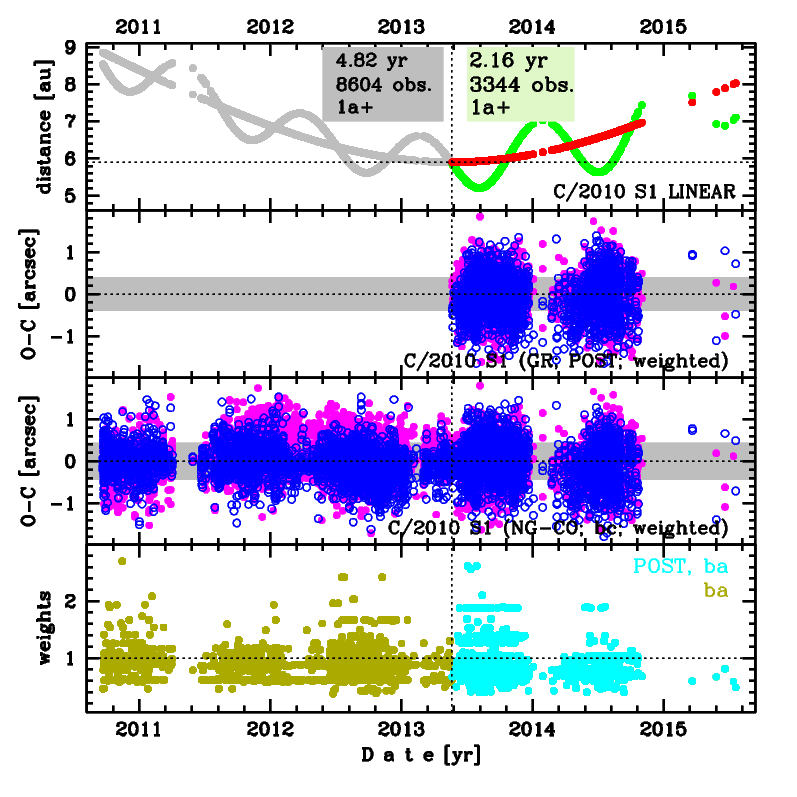C/2010 S1 LINEAR
more info
Comet C/2010 S1 was discovered on 21 September 2010 and next observed almost continuously by 4.8 yr in a range of heliocentric distances: 8.85 au – 5.900 au (perihelion) – 8.02 au. At the moment of discovery, it was two years and eight months before perihelion passage (see figure).
Comet had its closest approach to the Earth on 4 August 2013 (5.205 au, 2.5 months after perihelion).
NG orbit is possible to obtained using the full data arc; however uncertainties of NG parameters are notable, especially for A2 (see solutions ac and bc differing only in data weighting).
This Oort spike comet suffers a tiny planetary perturbations during its passage through the planetary system.
See also Królikowska and Dones 2023 and Królikowska and Dybczyński 2017.
Comet had its closest approach to the Earth on 4 August 2013 (5.205 au, 2.5 months after perihelion).
NG orbit is possible to obtained using the full data arc; however uncertainties of NG parameters are notable, especially for A2 (see solutions ac and bc differing only in data weighting).
This Oort spike comet suffers a tiny planetary perturbations during its passage through the planetary system.
See also Królikowska and Dones 2023 and Królikowska and Dybczyński 2017.
| solution description | ||
|---|---|---|
| number of observations | 3344 | |
| data interval | 2013 05 21 – 2015 07 19 | |
| data arc selection | data generally limited to post-perihelion (POS) | |
| range of heliocentric distances | 5.9 au – 5.90 au (perihelion) – 8.02 au | |
| detectability of NG effects in the comet's motion | comet with determinable NG~orbit | |
| type of model of motion | GR - gravitational orbit | |
| data weighting | YES | |
| number of residuals | 6556 | |
| RMS [arcseconds] | 0.41 | |
| orbit quality class | 1a+ | |
| next orbit statistics, both Galactic and stellar perturbations were taken into account | ||
|---|---|---|
| no. of returning VCs in the swarm | 5001 | * |
| no. of escaping VCs in the swarm | 0 | |
| no. of hyperbolas among escaping VCs in the swarm | 0 | |
| next reciprocal semi-major axis [10-6 au-1] | 70.23 – 71.02 – 72.07 | |
| next perihelion distance [au] | 92.4 – 97.8 – 100 | |
| next aphelion distance [103 au] | 27.7 – 28.1 – 28.4 | |
| time interval to next perihelion [Myr] | 1.49 – 1.51 – 1.52 | |
| percentage of VCs with qnext > 20 | 100 | |

Upper panel: Time distribution of positional observations with corresponding heliocentric (red curve) and geocentric (green curve) distance at which they were taken. The horizontal dotted line shows the perihelion distance for a given comet whereas vertical dotted line — the moment of perihelion passage.
Middle panel(s): O-C diagram for a given solution (sometimes in comparison to another solution available in CODE), where residuals in right ascension are shown using magenta dots and in declination by blue open circles.
Lowest panel: Relative weights for a given data set(s).
Middle panel(s): O-C diagram for a given solution (sometimes in comparison to another solution available in CODE), where residuals in right ascension are shown using magenta dots and in declination by blue open circles.
Lowest panel: Relative weights for a given data set(s).
| next_g orbit statistics, here only the Galactic tide has been included | ||
|---|---|---|
| no. of returning VCs in the swarm | 5001 | * |
| no. of escaping VCs in the swarm | 0 | |
| no. of hyperbolas among escaping VCs in the swarm | 0 | |
| next reciprocal semi-major axis [10-6 au-1] | 75.40 – 75.94 – 76.50 | |
| next perihelion distance [au] | 6.0923 – 6.0974 – 6.1025 | |
| next aphelion distance [103 au] | 26.14 – 26.33 – 26.52 | |
| time interval to next perihelion [Myr] | 1.49 – 1.51 – 1.53 | |
| percentage of VCs with qnext < 10 | 100 | |